


 |
Florida Trip Day 11 (Fort Lauderdale) |
 |
Florida Trip Days 5-9 (Fort Lauderdale) |
 |
Return to the Florida Trip Master Index |
As it turned out, Steve and Mario, our good friends, were also in Florida for part of the time we were here. They come down to Miami, where both their families live, to visit them a couple of times a year, and one of those times is usually in the Fall. I believe they had flown down two days after we left, and now they have both had a good visit with their families, and are going to spend a couple of days with us before flying back to Dallas from Fort Lauderdale.
We've coordinated our plans for today, and Fred and I are going to drive first to Steve's parent's house, pick him up, then drive to Mario's folk's place and collect him, and then, probably, go to the Fairchild Gardens Tropical Park.
Collecting Steve and Mario
Getting to Steve's Parent's House
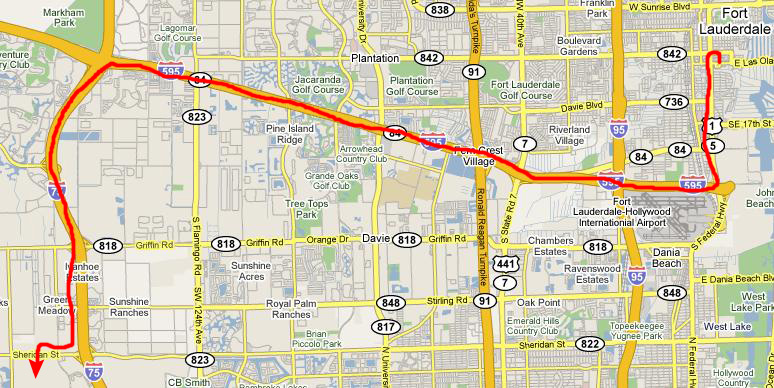 |
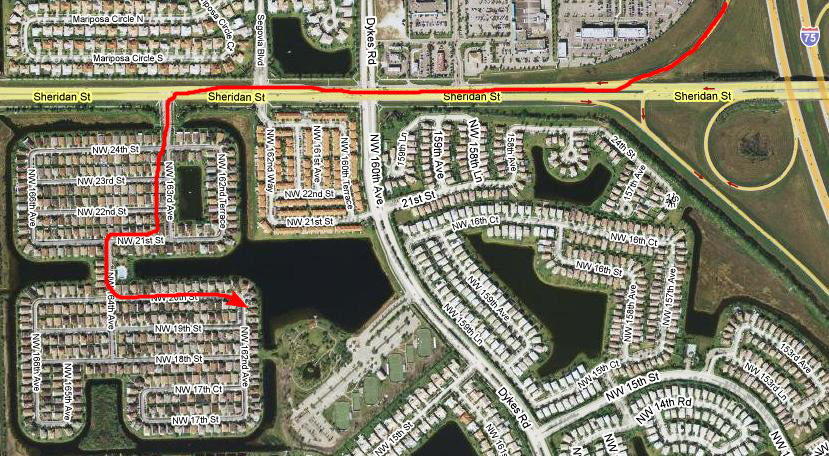 |
Steve's parents live in a nice two-story house right on the shore of an artificial lake, and we had a nice visit with them before we picked Steve up and headed over to Mario's parent's house.
Getting to Mario's Parent's House
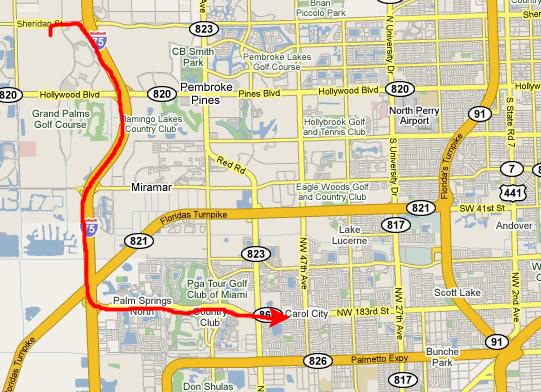 |
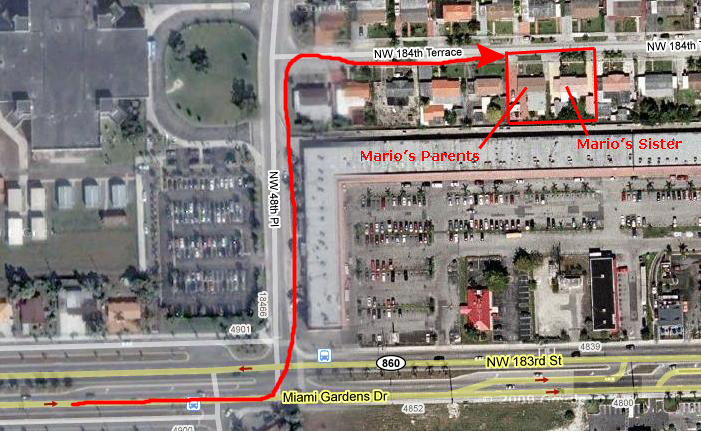 |
We spent a half-hour or so at Mario's, meeting his parents and seeing his sister again. His parents speak little English, so Mario had to be the translator. They have a very nice little family compound. His parents actually live in a small house behind a larger one where his brother lives, so the whole extended family is close together.
When we were done visiting, we picked up Mario and his stuff and headed off to Fairchild Tropical Gardens.
Fairchild Tropical Botanic Garden
The History of Fairchild Tropical Botanic Garden
Dr. Fairchild retired to Miami in 1935, sharing his vast knowledge and experience in tropical plants with Col. Robert H. Montgomery, who founded the botanical garden and named it to honor his friend. Many plants still growing in the Garden were collected and planted by Dr. Fairchild, including a giant African baobab tree not far from the entrance. Before WWII, Dr. Fairchild conducted collecting expeditions to the Far East for FTBG.
Opened to the public in 1938, Fairchild was established on an 83-acre site south of Miami purchased by Col. Montgomery and later deeded in large part to Miami-Dade County. Fairchild Tropical Botanic Garden was designed by renowned landscape architect William Lyman Phillips, member of the Frederick Law Olmsted partnership, and the leading landscape designer in South Florida during the 1930s.
The first 15 years saw the construction of its primary buildings and landscape features, including the Montgomery Palmetum, Bailey Palm Glade, Allee and Overlook, Vine Pergola, Amphitheatre, Gate House, Montgomery Library and Museum, 11 lakes, stone terracing walls, irrigation systems, Moos Sunken Garden, and Nell Montgomery Garden House auditorium. Later buildings included the Davis House (1953), Hawkes Laboratory (1960), Robbins Plant Science Building (1967), Rare Plant House (1968), Corbin Education Building (1972), and various additions over the years. A comprehensive master plan developed in 1993 provides a framework for continued growth and development.
Assembling and maintaining an outstanding botanical collection has been a fundamental part of the institution's existence since 1938; the palms and cycads are still the most significant Fairchild collections. Since Hurricane Andrew in 1992, Fairchild plant collecting efforts have intensified dramatically, as scientists seek not only to restore the FTBG collections, but also to identify and save endangered plants throughout the tropics. Since 1938, FTBG has distributed plants and seeds both to fellow scientists and to members of the local community. Fairchild palms, cycads, ornamentals and fruit trees have been a source of new varieties for commercial growers and home gardeners alike.
Getting to the Fairchild Tropical Botanic Garden
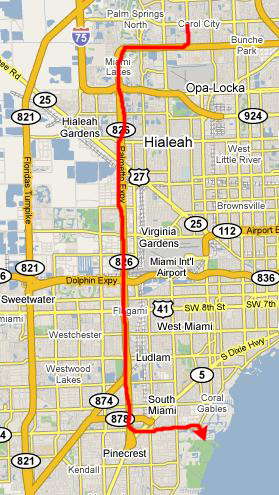 |
At SW 88th Street, we got off the expressway and headed east, almost to Biscayne Bay.
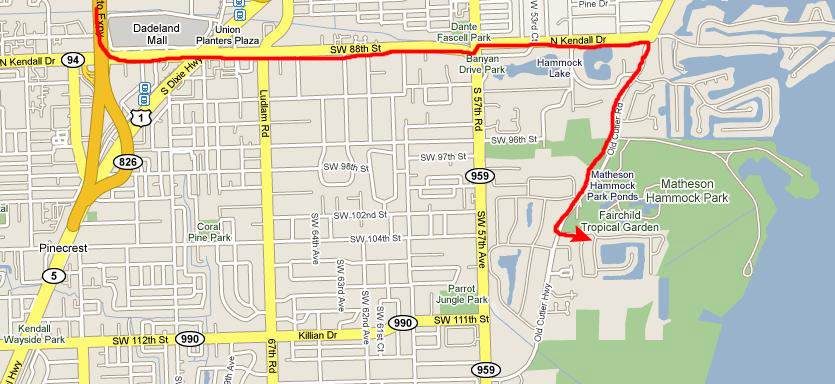 |
An Orientation to Fairchild Tropical Botanic Garden
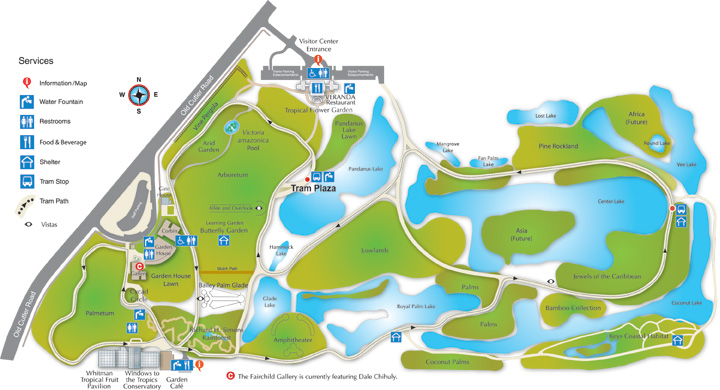 |
At the east end of the garden, towards Biscayne Bay, there are large areas devoted to particular ecosystems amid many small lakes and ponds. Here you can find a pine barren ecosystem, a lowlands ecosystem, palms and coconut palms and bamboo stands. There is also an area devoted to plants of the Caribbean. Two areas are under development, one which will be devoted to plants of Africa and the other to plants of Asia.
In our walks today, we'll be making a loop, generally, from the Visitor Center to the cafe on the south side of the garden, through the greenhouses in the southwest corner, and then back north along the west side of the gardens. Then, we'll return to the center of the garden and make a loop to the east and back, going towards Biscayne Bay along the garden's north side and returning along the south.
Walking from the Visitor Center to the Cafe
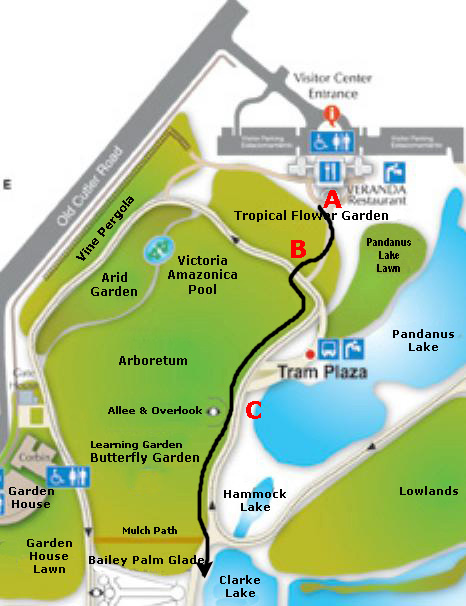 |
Immediately south of the visitor center, as we were walking down the path, we passed through a garden area with exhibits of various tropical plants, flowers and trees (marked "B" on the map at left).
Interesting Trees
Another very interesting specimen was a tree with some of the most unusual bark that I've ever seen. The bark was multi-colored, and almost looked like a modern painting. How the sheathing on the tree got those colors I have no idea, but reminded me of the Padrone trees we'd seen in Oregon.
But probably the most unusual of the trees I saw here was one that had developed what I can only assume is some sort of defense mechanism. It is called the "Silk Floss Tree." The exterior of the trunk of the tree was covered in randomly‑sized thorns. The thorns were also multi-colored and all of different sizes, and, apparently, randomly arranged. It looked for all the world as if someone had come along and simply stuck them on; there was no pattern I could discern. I can only assume that the thorny structures evolved to keep animals from climbing the tree and eating the fruit, before the tree had a chance to reproduce. This tree was pretty amazing; I have never seen anything like it.
Plants and Flowers

|
Anoles and Iguanas
One native reptile, the green anole is fast becoming outnumbered by invasive anoles from the Caribbean and Central America. In fact, on any given day, it struggles to compete, as it gets pushed out of its habitat. Perhaps the most troublesome introduced reptile is the green iguana, which thrives without any natural predators. It freely consumes prized leaves, fruits and flowers, thereby threatening the scientific plant collections at Fairchild, home gardens in Florida and some of the state's rarest plant species.
We certainly did see a lot of lizards and iguanas, and actually got close enough to take a few pictures of some of them; most of these pictures were taken along the shore of Pandanus Lake, at about the spot marked "C" on the map above. If you will click on the thumbnail images below, you can see some of the reptiles we saw today in the gardens:

|
We continued walking south along the path towards the cafe. We passed a raised planted area that the guide map referred to as the Allee and Overlook and then passed the Learning Garden. Just before we reached the cafe, we passed Clarke Lake and you can see some of the eastern part of the gardens in the background.
The Cafe and Greenhouses
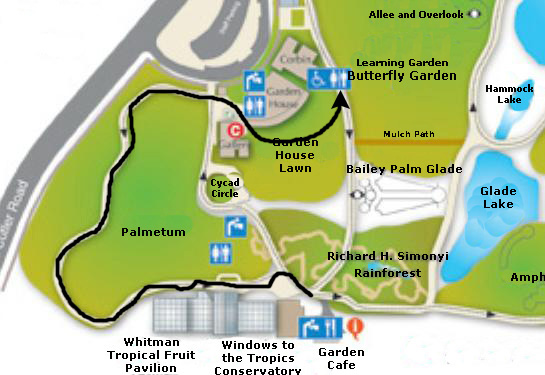 |
Windows to the Tropics Conservatory
In the epiphyte room there is a rainforest canopy. Here, there are lots of plants that thrive above ground level by attaching themselves to other plants or other objects for support. Epiphytes are not parasitic and cause no direct harm to the plant they are attached to. Here there are epiphytic ferns, bromeliads, and orchids that bloom throughout the year.
There is also a horticultural display room, and other greenhouses supply the potted plants that rotate through this display. Here are some of Fairchild's most prized aroids, bromeliads and orchids, along with unusual new species and horticultural selections. One highlight is the 40-foot-long Tillandsia screen that displays plants suspended in mid-air. The conservatory also has one of the world's largest ferns, Angiopteris evecta, that can produce fronds up to 40 feet long and a rare Pelagodoxa henryana (only ten or so individual plants left in the wild). The Cyrtostachys renda ( red sealing wax palm) thrives in hot humid conditions, and many other plants produce intoxicating fragrances Throughout the conservatory there wre flowering trees, palms and cycads, aroids, and ferns representing the plant diversity of the tropical world.
|
|
There were many interesting and beautiful plants and trees inside the Tropics Conservatory, and we took a wide range of pictures. I have selected the best of these pictures to include here. If you will click on each of the thumbnail images below, you can see the best of the pictures we took:

|
|
|
Whitman Tropical Fruit Pavilion

|
The Palmetum
Along this part of the walk, we again found a number of interesting plants, and we recorded a number of them in pictures. Click on the thumbnail images below to see these pictures:

|
|
|
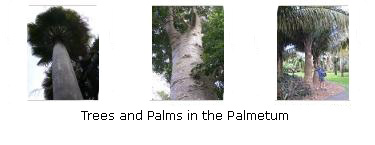
|
Fred brought me over to where he was looking at one particular tree and suggested I make a movie of it to really give you an idea of what it was like. You can watch that movie with the player at left.
The Sunken Garden
|
|
The Arid Garden and Victoria Pool
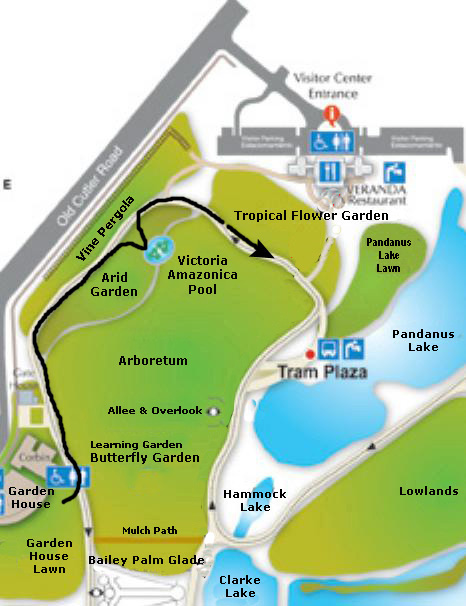 |
The Arid Garden

|

|

|
The Victoria Amazonica Pool
|
|
Visitor Center Display Gardens
Finally, we reached the Visitor Center again, and had a chance to go through some garden beds that we hadn't seen when we first started out. There were lots of interesting plants here, and if you will click on the thumbnail images below you can see the full-size pictures of some of them:

|
The Other Areas of Fairchild Gardens
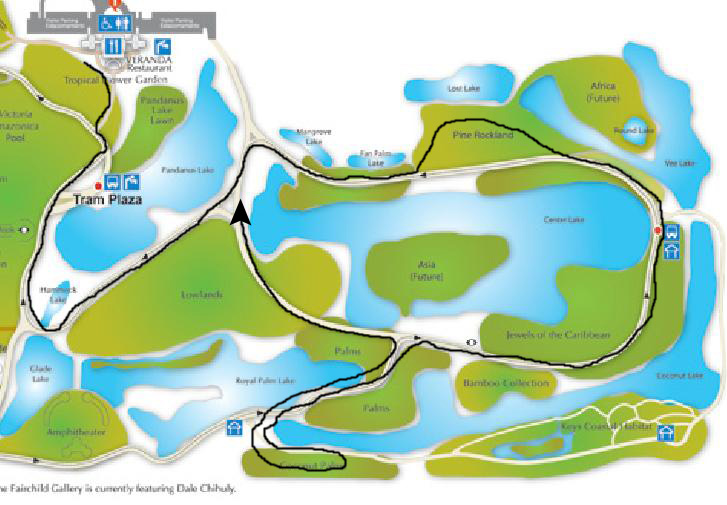 |
We went south again on the park walk and around the bottom of Hammock Lake and then up across the top of an area called "The Lowlands," just on the other side of Pandanus Lake and the Visitor Center. We came around the lowlands, and then crossed a main park road heading east by Fan Palm Lake. Here, Fred found some tropical birds almost hidden away among the mangrove roots at the edge of the lake.
Walking further on, we detoured through the Pine Rockland, and we could get a view across Vee Lake towards an area marked as "Africa (future)" on the park brochure map (and the map duplicated at left). About here, Fred also noticed a tropical wading bird, and thought a picture was worthwhile.
We continued around the end of Center Lake, and passed through areas of bamboo, palms and coconut palms. The whole area was very restful, and there was almost no one in sight all throughout this part of our walk. We didn't take many pictures here, but I have included three that turned out well, and you can see them if you click on the thumbnail images below:
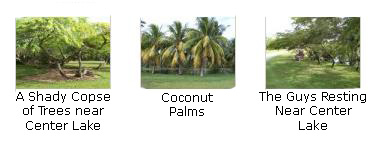
|
Returning to Fort Lauderdale - Evening
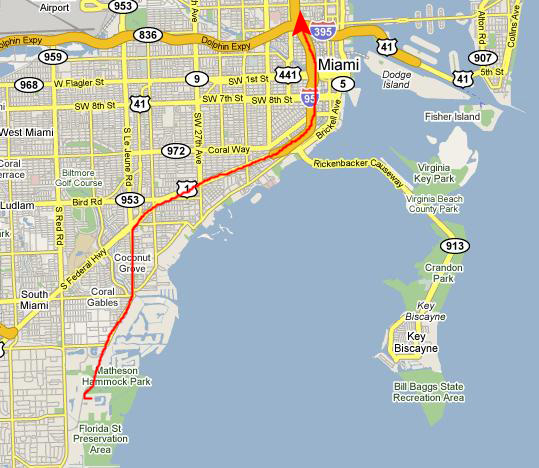 |
We left the Gardens and headed up Old Cutter Road to Le Jeune Road, and then took that north until it intersected with US-1. We took that north where it merged into the southern beginning of I-95, and we took that north.
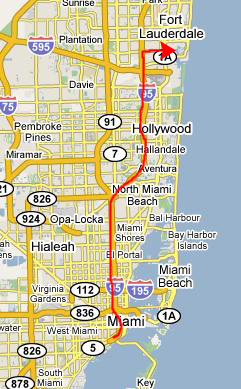 |
When everyone got settled, we made some drinks and went down to the Riverview Gardens dock where we sat, drank and talked and watched the sunset over the New River.
Then we walked down to the Floridian for dinner.
Use the links below to take a look at another album page for our Florida trip.
 |
Florida Trip Day 11 (Fort Lauderdale) |
 |
Florida Trip Days 5-9 (Fort Lauderdale) |
 |
Return to the Florida Trip Master Index |